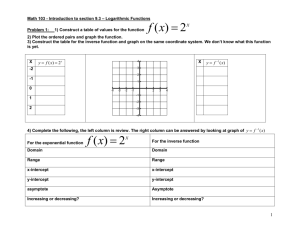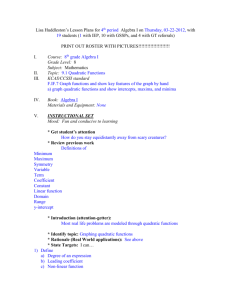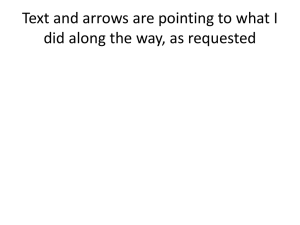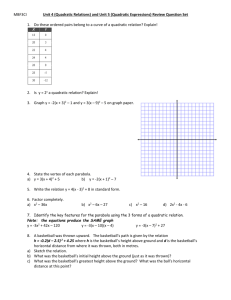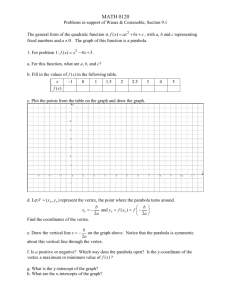Math 1
advertisement
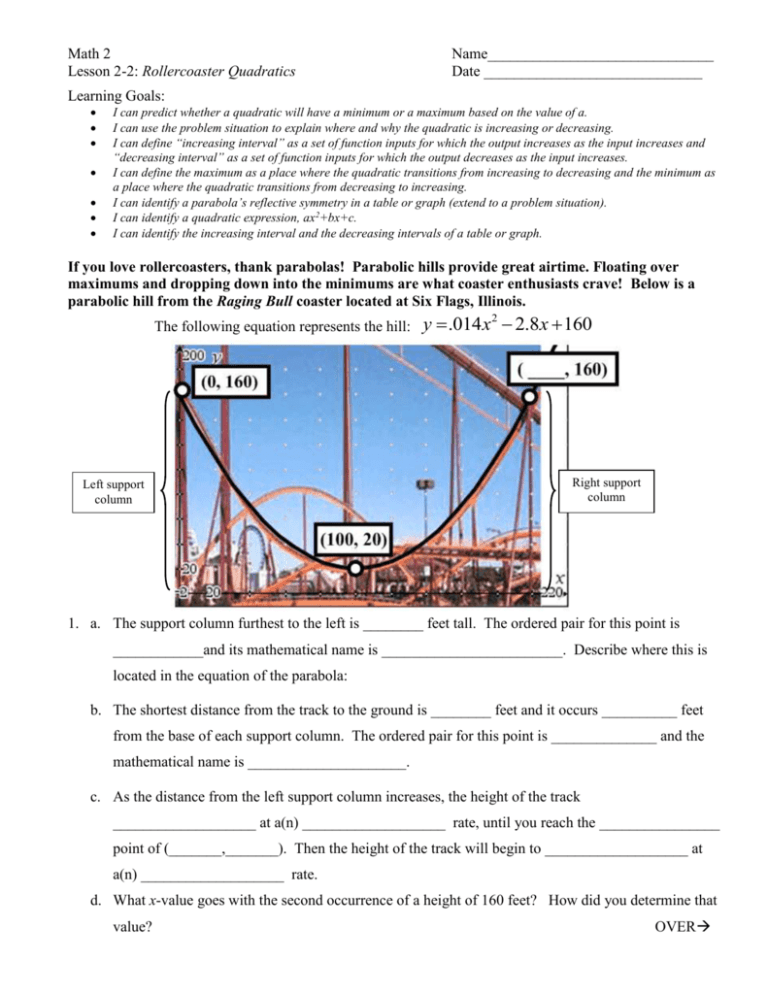
Math 2 Lesson 2-2: Rollercoaster Quadratics Name______________________________ Date _____________________________ Learning Goals: I can predict whether a quadratic will have a minimum or a maximum based on the value of a. I can use the problem situation to explain where and why the quadratic is increasing or decreasing. I can define “increasing interval” as a set of function inputs for which the output increases as the input increases and “decreasing interval” as a set of function inputs for which the output decreases as the input increases. I can define the maximum as a place where the quadratic transitions from increasing to decreasing and the minimum as a place where the quadratic transitions from decreasing to increasing. I can identify a parabola’s reflective symmetry in a table or graph (extend to a problem situation). I can identify a quadratic expression, ax2+bx+c. I can identify the increasing interval and the decreasing intervals of a table or graph. If you love rollercoasters, thank parabolas! Parabolic hills provide great airtime. Floating over maximums and dropping down into the minimums are what coaster enthusiasts crave! Below is a parabolic hill from the Raging Bull coaster located at Six Flags, Illinois. The following equation represents the hill: Left support column y .014 x 2 2.8x 160 Right support column 1. a. The support column furthest to the left is ________ feet tall. The ordered pair for this point is ____________and its mathematical name is ________________________. Describe where this is located in the equation of the parabola: b. The shortest distance from the track to the ground is ________ feet and it occurs __________ feet from the base of each support column. The ordered pair for this point is ______________ and the mathematical name is _____________________. c. As the distance from the left support column increases, the height of the track ___________________ at a(n) ___________________ rate, until you reach the ________________ point of (_______,_______). Then the height of the track will begin to ___________________ at a(n) ___________________ rate. d. What x-value goes with the second occurrence of a height of 160 feet? How did you determine that value? OVER Page 2 2. Go back to the graph of the rollercoaster hill. a. Lightly shade the parts of the track that are at least 100 feet above the ground. Use the x-values to describe the intervals of the track that you shaded. Do so by completing the compound inequalities below. ________ < x < ________ ________ < x < ________ b. Now shade the part of the track that is at most 50 feet above the ground. Describe the interval by completing the compound inequality below. ________ < x < ________ c. Below is a table of values representing some ordered pairs that make up the parabola. x (feet) 0 40 60 80 100 140 160 180 200 y (feet) 160 109.6 42.4 25.6 20 25.6 70.4 109.6 Underline the input/output pair of numbers that represent the y-intercept of the function. From the table, how do you know this is the y-intercept? Circle the input/output pair of numbers that represent the minimum of the function. From the table, how do you know this is the minimum? There are some values in the table that have not been filled in. Use the symmetric nature of the parabola to fill in each of those values. What is happening to the rates of change as the values approach the minimum? How do you know from the table? What is happening to the rates of change after the minimum? How do you know from the table? ***Verify your intervals from 2a & 2b by making a table in the calculator. Also, confirm the values you filled in the table. To make a table: ctrl T menu 2: Table 5: Edit Table Settings . . . Page 3 3. Recall that the height function for dropping pumpkins was h(t ) 144 16t and for a basketball long shot was h(t ) 8 40.8t 16t 2 . 2 Describe the similarities between the graphs of the rollercoaster hill and those of the pumpkin drop and basketball functions. Describe the differences between the graphs of the rollercoaster hill and those of the pumpkin drop and basketball functions. ***How is the rule for the rollercoaster hill function similar to and how is it different from the rules of the pumpkin drop and basketball functions? PRACTICE 1. Below is a picture of the third hill (taller one) of the Intimidator rollercoaster at Carowinds amusement park, located in North Carolina. Suppose the following equation represents the graph of the hill, where x represents the horizontal distance in feet and y represents the vertical distance in feet. y .00832 x 2 2.08 x 20 a. Complete the table of values and then graph the function. x (feet) 0 25 50 75 100 125 150 175 200 225 250 y (feet) b. What are the coordinates of the y-intercept? _________ How do you know from the table? From the equation? c. What are the coordinates of the point where the tallest support column meets the track? __________ What is the mathematical name of this point? ____________________________ d. Use a compound inequality to describe the x-values where the track is at least 140 feet above the ground. e. Use compound inequalities to describe the x-values where the track is at most 85 feet above the ground. OVER Page 4 2. Answer the following questions about the equation: y 2 x 5x 20 2 ***NO CALCULATOR*** a. Is this function linear or non-linear? How do you know? b. Does this parabola have a maximum or a minimum (which one)? How do you know? c. What is the y-intecept of this function? How do you know? d. Complete the table of values. x y 0 .5 1 1.5 2 2.5 3 3.5 4 4.5 5 5.5 -12 -6.5 1.5 5.5 6 4 1.5 -2 e. Underline the input/output pair of numbers that represent the y-intercept of the function. f. Circle the input/output pair of numbers that represent the maximum of the function. g. Describe what is happening to the rates of change as the values approach the maximum. h. Describe what is happening to the rates of change of the values after maximum.



